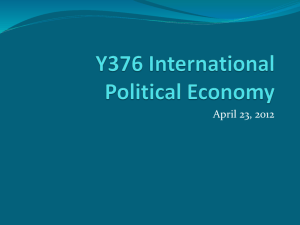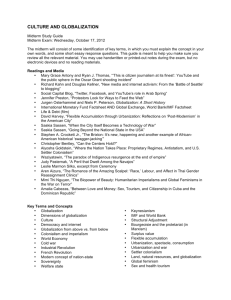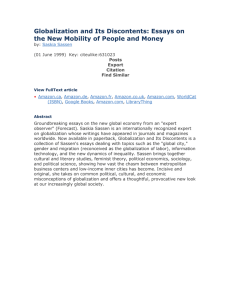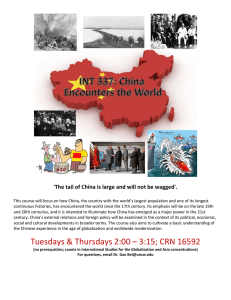The Global City The De-Nationalizing of Time and Space Saskia Sassen
advertisement
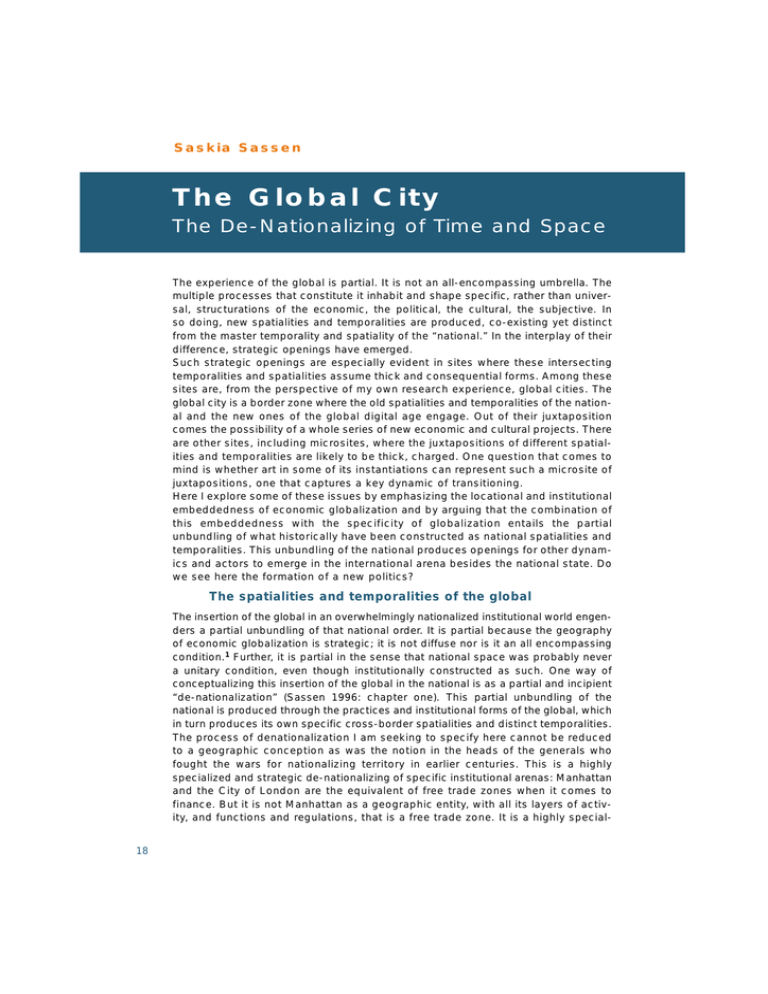
Saskia Sassen The Global City The De-Nationalizing of Time and Space The experience of the global is partial. It is not an all-encompassing umbrella. The multiple processes that constitute it inhabit and shape specific, rather than universal, structurations of the economic, the political, the cultural, the subjective. In so doing, new spatialities and temporalities are produced, co-existing yet distinct from the master temporality and spatiality of the “national.” In the interplay of their difference, strategic openings have emerged. Such strategic openings are especially evident in sites where these intersecting temporalities and spatialities assume thick and consequential forms. Among these sites are, from the perspective of my own research experience, global cities. The global city is a border zone where the old spatialities and temporalities of the national and the new ones of the global digital age engage. Out of their juxtaposition comes the possibility of a whole series of new economic and cultural projects. There are other sites, including microsites, where the juxtapositions of different spatialities and temporalities are likely to be thick, charged. One question that comes to mind is whether art in some of its instantiations can represent such a microsite of juxtapositions, one that captures a key dynamic of transitioning. Here I explore some of these issues by emphasizing the locational and institutional embeddedness of economic globalization and by arguing that the combination of this embeddedness with the specificity of globalization entails the partial unbundling of what historically have been constructed as national spatialities and temporalities. This unbundling of the national produces openings for other dynamics and actors to emerge in the international arena besides the national state. Do we see here the formation of a new politics? The spatialities and temporalities of the global The insertion of the global in an overwhelmingly nationalized institutional world engenders a partial unbundling of that national order. It is partial because the geography of economic globalization is strategic; it is not diffuse nor is it an all encompassing condition. 1 Further, it is partial in the sense that national space was probably never a unitary condition, even though institutionally constructed as such. One way of conceptualizing this insertion of the global in the national is as a partial and incipient “de-nationalization” (Sassen 1996: chapter one). This partial unbundling of the national is produced through the practices and institutional forms of the global, which in turn produces its own specific cross-border spatialities and distinct temporalities. The process of denationalization I am seeking to specify here cannot be reduced to a geographic conception as was the notion in the heads of the generals who fought the wars for nationalizing territory in earlier centuries. This is a highly specialized and strategic de-nationalizing of specific institutional arenas: Manhattan and the City of London are the equivalent of free trade zones when it comes to finance. But it is not Manhattan as a geographic entity, with all its layers of activity, and functions and regulations, that is a free trade zone. It is a highly special18 WHO IS UNPLUGGED ? ized functional or institutional realm that becomes de-nationalized. However, this set of institutions has distinct locational patterns—a disproportionate concentration in global cities. And this has the effect of re-territorializing even the most globalized, digitalized and partly dematerialized industries and markets. But this re-territorializing has its own conditionality—a complex and dynamic interaction with national state authority. The strategic spaces where many global processes are embedded are often national; the mechanisms through which new legal forms, necessary for globalization, are implemented are often part of state institutions; the infrastructure that makes possible the hypermobility of financial capital on the global scale is embedded in various national territories. Thus one way of conceiving of the inevitable negotiations with the national is in terms of this partial and strategic dynamic of de-nationalization. 2 From this perspective, understanding the spatiality of economic globalization only in terms of hypermobility and space/time compression— the dominant markers in today’s conceptualization—is inadequate. Hypermobility and space/time compression need to be produced, and this requires vast concentrations of very material and not so mobile facilities and infrastructures. And they need to be managed and serviced, and this requires mostly place-bound labor markets for talent and for low-wage workers. The global city is emblematic here, with its vast concentrations of hypermobile dematerialized financial instruments and the enormous concentrations of material and place-bound resources that it takes to have the former circulating around the globe in a second. 3 Even the vast new economic topography that is being implemented through electronic space is one moment, one fragment, of an even vaster economic chain that is in good part embedded in non-electronic spaces. The most advanced information industries, such as finance, are installed only partly in electronic space. And so are industries that produce digital products, such as software designers. The growing digitalization of economic activities has not eliminated the need for major international business and financial centers and all the material resources they concentrate, from state of the art telematics infrastructure to brain talent. We tend to operate in topographies that weave between actual and digital space. There is no purely virtual firm or human, even as we are increasingly relocating activities to digital spaces and locating digital capacities in the human body. Yet, complex as these dynamics of newly produced and newly unbundled spatialities are, they are not enough to specify the processes that constitute economic globalization. Its strategic economic projects have emerged in the play between two master/monster temporalities, within which we exist and transact (and enact all kinds of microtemporalities). One of these is a collapsing temporality—that of the national state as a historic institution, a master temporality often thought of as historic time. The other is a new temporality, that of economic globalization. In the intersection of these two co-existing temporalities we see the formation of new 19 Saskia Sassen economic dynamics/opportunities that drive and constitute economic globalization and can be thought of as partly de-nationalized temporalities (see Sassen 2000). Elsewhere I have argued that what we could think of as the dominant narrative or mainstream account of economic globalization is a narrative of eviction (Sassen 1998: chapter 1). Key concepts in the dominant account of globalization, information economy, and telematics all suggest that place no longer matters and that the only type of worker that matters is the highly educated professional. This account privileges the capability for global transmission over the concentrations of built infrastructure that make transmission possible. This includes information outputs over the workers producing those outputs, from specialists to secretaries, and the new transnational corporate culture over the multiplicity of cultural environments, including reterritorialized immigrant cultures, within which many of the “other” jobs of the global information economy take place. In brief, the dominant narrative concerns itself with the upper circuits of capital, not the lower ones, and with the global capacities of major economic actors, not the infrastructure of facilities and jobs underlying those capacities. This narrow focus has the effect of evicting from the account the place-boundedness of significant components of the global information economy and the fact that there is a far broader range of types of urban spaces involved than some of the master images suggest. Insofar as an economic analysis of the global city recovers the broad array of jobs and work cultures that are part of the global economy though typically not marked as such, it allows us to examine the possibility of a new politics of traditionally disadvantaged actors operating in this new transnational economic geography. This is a politics that lies at the intersection of economic participation in the global economy and the politics of the disadvantaged, and in that sense would add an economic dimension, specifically through those who hold the other jobs in the global economy—from factory workers in export processing zones to cleaners on Wall Street. The centrality of place in a context of global processes engenders a transnational economic and political opening in the formation of new claims and hence in the constitution of entitlements, notably rights to place, and, at the limit, in the constitution of “citizenship” (Copjec and Sorkin 1999; Social Justice 1993). The city has indeed emerged as a site for new claims, by global capital which uses it as an “organizational commodity,” but also by disadvantaged sectors of the urban population, frequently as internationalized a presence in large cities as capital. The de-nationalizing of urban space and the formation of new claims centered in transnational actors and involving contestation, raise the question, Whose city is it? I see this as a type of political opening that contains unifying capacities across national boundaries and sharpening conflicts within such boundaries. Global capital and the new immigrant workforce are two major instances of transnationalized categories that have unifying properties internally and find themselves in contestation with each other inside global cities. 4 Revisiting The Edge The partial unbundling of the national through the insertion of the global into it produces a re-scaling of old hierarchies—running from the local, regional, national, on to the global. Going to the next scale in terms of size is no longer how integration is achieved. The local now transacts directly with the global—the global installs itself in locals and the global is itself constituted through a multiplicity of locals. 5 20 WHO IS UNPLUGGED ? The distinction between the global and the local needs to be rethought, notably the assumption about the necessity of proximity in the constitution of the “local.” For example, both the new international professionals and immigrant workers operate in contexts which are at the same time local and global. The new professionals of finance are members of a cross-border culture that is in many ways embedded in a global network of “local” places— a set of particular international financial centers, with much circulation of people, information and capital among them. Further, as financial centers, London, New York, Zurich, Amsterdam, Frankfurt, are all part of an international yet very localized work sub-culture. We see here “proximity” but not one embedded in territorial space. It is, rather, a deterritorialized form of proximity containing multiple territorial moments. And many immigrants will tend to be part of a cross-border network that connects specific localities—their new communities and their localities of origin in home countries. Though in a manner different from the financiers, they nonetheless also have the experience of deterritorialized local cultures, not predicated on locational proximity. 6 One way of reading this is as a tearing away of the “context” or the “surrounding” and its replacement with the fact of the global. The strategic operation is not the search for a connection with the “surroundings,” the context. It is, rather, installation in a strategic cross-border geography constituted through multiple “locals.” The spatiality thus produced can be thought of as a cross-border network of specific sites embedded partly in the national but constituted through spatial and temporal practices that distinguish these from others, notably those of the national, as historically constructed. 7 Two points come to mind First, global cities structure a zone that can span the globe but it is a zone embedded in/juxtaposed with older temporalities and spatialities. In the case of the research I have done on the new interface economies which dominate the global city, I find that it is precisely this juxtaposing which produces it. I would be interested in understanding whether in the case of the microenvironments represented by certain kinds of art, for instance digitally produced environments or objects, there is a similar dynamic of what appear as opposites but are in fact mutual presuppositions. Such microenvironments might present themselves as self-contained settings made possible by digital capacities; yet they may well arise precisely out of the fact of the limitations of the non-digital condition and in this sense be engendered, ironically by what they are not. Financial capital illustrates the more general point I am trying to make. I have argued elsewhere that its ascendance and capacity to subject other forms of capital to its own modes has to do with the co-existence of the different temporalities (much shorter for finance than that of other forms of capital) and spatialities (hypermobility of finance’s dematerialized outputs) of finance compared with other forms of capital. Finance by itself, without the other forms of capital, could not do much with its own speeds (Davidson 1999). How would this type of juxtaposition of differences work out in an analysis of the microenvironments of certain forms of art? Microinstantiations of this dynamic, as in art, might, it seems to me, be subject to the same tension between global span and sited materialities. Here I find interesting conceptual resonances with art projects that negotiate the relationship between the almost limitless freedom (so to speak) of certain forms and the constraints of the 21 Saskia Sassen materials that might go into its execution. This revisits the tension between that which is experienced as limitless, dematerialized capacity, as in the digital, and materialities that are sited. Secondly, although it spans the globe, the new zone that is being structured spatially and temporally is inhabited/constituted by multiple units or locals—it is not only a flow of transactions or one large encompassing system. The global city is a function of a global network—there is no such thing as a single global city as you might have had with the empires of old, each with its capital. This network is constituted in terms of nodes of hyperconcentration of activities and resources. What connects the nodes is dematerialized digital capacity; but the nodes incorporate enormous numbers and types of materialities, sited materialities. This means that we need to decode what is local (or national?) in such locals, in what has historically been constructed as local because sited in a place. And it means specifying what are the new territorial and institutional conditionalities of the local—of that which is present in a place—in a global and digital era. These features raise questions about how the edge works, about the presence or absence of intersections between different environments, about what happens to contextuality. The orientation is simultaneously towards itself and towards the global. The intensity of each environment’s internal transactions is such that it overrides all considerations of the broader locality or context within which it exists, The new networked subeconomy of the global city occupies a strategic geography that is partly deterritorialized, cuts across borders and connects a variety of points on the globe. It occupies only a fraction of its “local” setting; its boundaries are not those of the city where it is partly located, nor those of the “neighborhood.” 8 How this would work for certain forms of art is not clear to me; but it is possible that the issue of the edge, the surrounding, the locus also holds for art that is marked by the intensity of its internal transactions and its cross-border, transnational rather than contextual orientation. Conclusion: Unbundlings And New Openings The unbundling of the national along with the specific dynamics of de-nationalization as instantiated in the global city have contributed to creating operational and conceptual openings for other actors and subjects. The ascendance of a large variety of non-state actors in the international arena signals the expansion of an international civil society. This is clearly a contested space, particularly when we consider, for example, the logic of the capital market —profitability at all costs—against that of the human rights regime. But it does represent a space where other actors can gain visibility as individuals and as collective actors, and come out of the invisibility of aggregate membership in a nation-state exclusively represented by the sovereign. There are two strategic dynamics I am isolating here: a) the incipient de-nationalizing of specific types of national settings, particularly global cities, and b) the formation of conceptual and operational openings for actors other than the national state in cross-border political dynamics, particularly the new global corporate actors and those collectivities whose experience of membership has not been subsumed fully under nationhood in its modern conception, e.g. minorities, immigrants, firstnation people, and many feminists. 22 WHO IS UNPLUGGED ? The large city of today emerges as a strategic site for these new types of operations. It is one of the nexi where the formation of new claims materializes and assumes concrete forms. The loss of power at the national level produces the possibility for new forms of power and politics at the subnational level. The national as container of social process and power is cracked. This cracked casing opens up possibilities for a geography of politics that links subnational spaces. Cities are foremost in this new geography. One question this engenders is how and whether we are seeing the formation of a new type of transnational politics that localizes in these cities. 1 There is disagreement in the literature on this point. Some authors see globalization as a universal and universalizing condition, especially when it comes to the sphere of consumption. In my research I have tended to focus on the sphere of “production,” by which I mean to include the operations necessary for the management and coordination of the global economy as well as those that organize the appropriation and control of profit. 2 Taking as the starting point the specificity of a national/local setting makes it possible to trace the resistances, accommodations, and inertias of the national to the agency of the global, whether this agency comes from the outside or from inside of the national. And it makes it possible to capture the many particular trajectories through which this insertion materializes in different institutional orders within different national states, the multiple forms it assumes, and the multiple cross-border networks that are thereby constituted. Dynamic processes and border zones emerge in the juxtapositions of the national and the global thus understood. (Sassen 2000a) 3 It is precisely the combination of the spatial dispersal of numerous economic activities and telematic global integration which has contributed to a strategic role for major cities in the current phase of the world economy (see e.g. Knox and Taylor 1995; Stren 1996; Cohen et al. 1996). Beyond their sometimes long history as centers for world trade and banking, these cities now function not only as command points in the organization of the world economy, but also as key locations and marketplaces for the leading industries of this period (finance and specialized services for firms), and as sites for the production of innovations in those industries. These cities have come to concentrate such vast resources and the leading industries have exercised such massive influence on the economic and social order of these cities that the possibility of a new type of city arises. 4 Immigration, for instance, is one major process through which a new transnational political economy is being constituted, one which is largely embedded in major cities insofar as most immigrants, whether in the US, Japan or Western Europe are concentrated in major cities. It is, in my reading, one of the constitutive processes of globalization today, even though not recognized or represented as such in mainstream accounts of the global economy. 5 I also see this in the political realm, particularly the kind of “global” politics attributed to the Internet. I think of it rather as a multiplicity of localized operations, but with a difference, they are part of the global network that is the Internet. This produces a “knowing” that re-marks the local. See the chapter “Electronic Space and Power” in Globalization and its Discontents (New York: New Press, 1998) 6 Thus, for instance, in my research on these two types of workers I have found that they operate in labor markets that are local even though not characterized by territorial proximity as the standard model of such markets would have it. 7 We can then think of the global economy as materializing in a worldwide grid of strategic places, uppermost among which are major international business and financial centers. We can think of this global grid as constituting a new economic geography of centrality, one that cuts across national boundaries and across the old North-South divide. See, e.g. Knox and Taylor 1995; Peraldi and Perrin 1996; 1993). A key aspect of the spatialization of global economic processes which I cannot develop here (but see Rötzer 1996; Futur Antérieur 1996; Sassen 1998: chapter 9) is digital space. 8 On another, larger scale, in my research on global cities I found rather clearly that these cities develop a stronger orientation towards the global markets than to their hinterlands. Thereby they override a key proposition in the urban systems literature, to wit, that cities 23 Saskia Sassen and urban systems integrate, articulate national territory. This may have been the case during the period when mass manufacturing and mass consumption were the dominant growth machines in developed economies and thrived on the possibility of a national scale. But it is not today with the ascendance of digitalized, globalized, dematerialized sectors such as finance. 9 I also see this in the political realm, particularly the kind of “global” politics attributed to the Internet. I think of it rather as a multiplicity of localized operations, but with a difference—they are part of the global network that is the Internet. This produces a “knowing” that re-marks the local. See the chapter “Electronic Space and Power” in Globalization and its Discontents (New York: New Press, 1998) References Cited Appadurai, Arjun. Modernity at Large, University of Minnesota Press, Minn., 1996 Cohen, Michael A., Blair A. Ruble, Joseph S. Tulchin, Allison M. Garland (eds). Preparing for the Urban Future. Global Pressures and Local Forces, Woodrow Wilson Center Press (Distributed by The Johns Hopkins University Press), Washington D.C., 1996 Copjec, J. and M.Sorkin. Giving Ground, Verso, London, 1999 Thierry Pillon and Anne Querrien (eds). La Ville-Monde Aujourd’hui: Entre Virtualité et Ancrage, Futur Antérieur. Special issue. Vols 30–32. L’Harmattan, Paris, 1995 Information Technologies and Inner-City Communities. The Journal of Urban Technology. Special Issue. Vol. 3, nr. 19 Fall). 1995 King, A.D. (ed). Representing the City. Ethnicity, Capital and Culture in the 21st Century, Macmillan, London, 1996. Paul L. Knox and Peter J. Taylor (eds). World Cities in a World-System, Cambridge University Press, Cambridge, UK, 1995 Mittelman, James (ed.) Globalization: Critical Reflections. International Political Economy Yearbook. Vol. 9. Lynne Rienner Publishers, Boulder, Co.,1996 Peraldi, Michel and Evelyne Perrin. (eds). Réseaux Productifs et Térritoires Urbains, Presses Universitaires du Mirail, Toulouse, 1996 Rötzer, Florian. Die Telepolis: Urbanität im digitalen Zeitalter, Bollmann. Mannheim, 1995 Sassen, Saskia. Globalization and Its Discontents, New press, New York, 1998 Losing Control? Sovereignty in an Age of Globalization. The 1995 Columbia University Leonard Hastings Schoff Memorial Lectures. Columbia University Press, New York, 1996 “Spatialities and Temporalities of the Global.” Public Culture, Millenium Issue on Globalization, 2000 Social Justice. Global Crisis, Local Struggles. Special Issue, Social Justice. Vol. 20, nrs. 3–4. Fall-Winter 1993. Stren, Richard. “The Studies of Cities: Popular Perceptions, Academic Disciplines, and Emerging Agendas.” Pp. 392-420 in Cohen et al. (eds), op.cit. 1996 24
